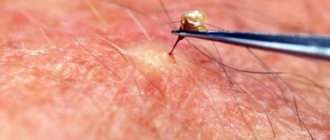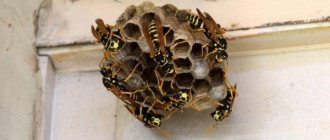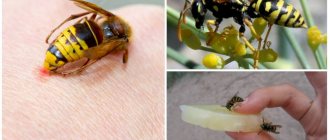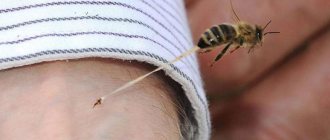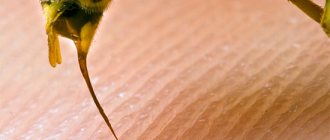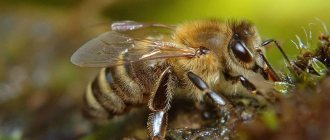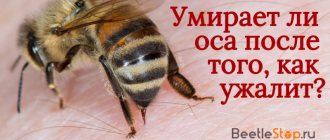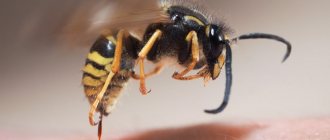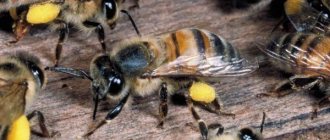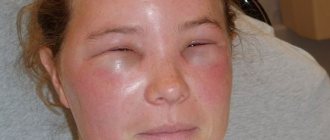What kind of organ is this and what are its dimensions?
A bee's sting is an organ measuring from 2 to 4.5 mm, which it inserts into the body of its offender, injecting poison, which causes pain and burning. Interestingly, the poison in the sting continues to be released even after the bite.
The sting has two parts:
- Motionless . It consists of: sled;
- sled processes;
- oblong plates;
- palps.
- triangular plate;
A bee needs a sting for defense, but it can only sting once, after which it dies. The fact is that when struck, the sting remains under the skin of the offender, and without it the bee cannot exist, since it is part of its body.
After being stung, the bee flies away from the offender with an open wound and dies.
Literature
- Chauvin R.
From bee to gorilla. - M., Mir, 1965. - 295 p. - Butler K. J.
The world of the honey bee. - M., 1980. - 232 p. - Vasilyeva E. N., Khalifman I. A. Bees. - M., 1981
- Radchenko V. G., Pesenko Yu. A. Biology of bees (Hymenoptera, Apoidea).
SPb.: Zool. Institute of the Russian Academy of Sciences. - 1994. - 350 p. - Greenfeld, E. K., 1978. The origin and development of anthophyly in insects
. - L.: Publishing house of Leningrad State University. — 203 p. - Eskov E. K. (1992). Ethology of the honey bee. M.: Kolos. 336.
- Eskov E. K. (1995). Ecology of the honey bee. Ryazan: Russian Word. 392 pp.
- Eskov E.K. (2013/2014). Biology of bees: encyclopedic dictionary-reference book. Publisher: Infra-M. 387 p. ISBN 9785160051277
- Eskov E. K. (2016). Evolution, ecology and ethology of the honey bee. M.: Infra-M. 291 p.
- Key to insects of the European part of the USSR. T. III. Hymenoptera. First part. // Suborder Apocrita – Stalk-bellied
(Arnoldi K.V. et al.) / under the general. ed. G. S. Medvedeva. - L.: "Science", 1978. - P. 279-518. — 584 p. — (Key guides to the fauna of the USSR, published by the Zoological Institute of the USSR Academy of Sciences; issue 119.). — 3500 copies. - Danforth, B. N., J. Fang, S. Sipes, S. G. Brady & E. Almeida (2004). Phylogeny and molecular systematics of bees (Hymenoptera: Apoidea).
Cornell University, Ithaca, NY Phylogeny of bees - Donovan, B. J. 2007: Apoidea (Insecta: Hymenoptera).
Fauna of New Zealand, 57. - Engel, M. S. (2005). Family-group names for bees (Hymenoptera: Apoidea).
American Museum Novitates 3476: 1-33. pdf - Michener, C. D. (2007) The bees of the world, second edition.
Johns Hopkins University Press, Baltimore and London, 953 pp.
Functions of the sting and characteristics of the poison
Initially, bees did not have a sting, but as a result of evolution, the ovipositor in the 11-12 segments of the abdomen turned into this organ and became an instrument for protecting honey. Only females have it, so drones do not sting. Thus, the functions of the stinger are to inject poison into the body of enemies to stop them and protect the hive. He can be attacked by:
- wasps;
- hornets;
- foreign bee colonies;
- ants;
- spiders;
- mice;
- rats;
- lizards;
- hedgehogs;
- the Bears.
Thanks to the stinger, worker bees can attack in case of danger and defend themselves. The poison released from it has a pleasant aroma and is a colorless liquid. This is a secret produced in 2 poisonous glands - large and small. In the bee's body it is contained in a special bag.
When studying the chemical composition of the venom, 13 amino acids and various compounds were identified, but its basis is melitin, a protein substance or peptide of bee venom. It has properties that can remove bacteria.
The functioning of the venom-producing gland depends on the age of the bee. If she has just crawled out of the cell, then the bag contains a minimal amount of poison. After a week of age, the reservoir is almost completely filled with a toxic substance. The maximum amount of poison is collected in the bag on the 15th day. When the bee becomes a “guard,” around day 19, the sac is completely filled with poison.
In bees emerging from the cell in the fall, the activity of the poison-producing gland begins much later (only on the 14th day) and ends on the 20th day.
It is worth noting that the queen bee uses the sting not only for her own protection, but also for laying eggs. This is one of the main functions of the uterus, because it must continue the birth. To strengthen oviposition, she places the sting in a perpendicular position. The queen bee has a longer length than the average bee.
Steps
Part 1
Remove the sting
1
Call 911 if you experience symptoms of a severe allergic reaction. Seek immediate medical attention if you have a history of severe allergic reactions to bee stings or if you experience any of the following symptoms: dizziness or loss of consciousness; labored breathing; swollen tongue; allergic rash.
2
Run the flat edge of an object over the sting. Using a credit card, your fingernail, or a dull knife, scrape the sting. It looks like a small black dot on the skin. This is done to prevent the venom sac from releasing more venom into the bite site. Swipe over the sting so that it comes out and to the side.
3
Using tweezers, remove the sting from the skin
If you don't want to scrape the stinger off, carefully pull it out of the skin with pointed tweezers or your fingernails. Try not to squeeze the visible end of the stinger, otherwise you will squeeze more venom into the skin.
Some people don't recommend using tweezers because you'll only squeeze out more venom.
However, the amount of venom released will not matter if you quickly remove the sting
Some people advise against using tweezers because this will only force out more venom. However, the amount of venom released will not matter if you quickly remove the stinger.
4
Apply a cold compress. The bite site will become inflamed and begin to swell. Apply ice to numb the bite and reduce swelling. If you are bitten on the arm or leg, elevate it above heart level.
Part 2
Treat the bite site
1
Apply hydrocortisone cream. If you want to use a more natural solution, mix baking soda with water to form a thick paste
Spread the paste over the bite area
Wash the bite area carefully with mild soap and water. Then apply a thin layer of hydrocortisone cream to minimize any possible reaction. 2
2
Apply honey. If you don't have hydrocortisone cream at home, apply natural honey to the bite site. Cover the bite area with gauze or a small piece of cloth. The honey can be washed off after about an hour.
3
Apply toothpaste. Toothpaste is another natural alternative that can be used to neutralize bee venom. Simply smear some toothpaste over the bite, cover it with gauze or a small piece of cloth and leave it there for 20-30 minutes. After 30 minutes, wash off the paste.
4
Take paracetamol or ibuprofen. Do not give paracetamol or ibuprofen to infants or young children. Buy painkillers for children and strictly follow the dosage instructions. This will help relieve the pain a little. Carefully follow the dosage instructions for the drug.
5
Take an antihistamine. This will help reduce the allergic reaction. Take diphenhydramine or apply sunburn cream to relieve itching.
How does a bee sting?
A bee has to sting to protect its hive. Her goal is not to kill, but to scare away the offender. The hive is especially well protected by “older” bees that have reached 19 days of age. The bee performs its actions in stages:
- Stage I. First, the insect lands on its enemy, that is, it comes into contact with its skin surface. Then it decides to sting him. The entire bite apparatus is located in a special bag-like chamber-case. When the bee is calm, the tip of the sting is hidden in it. In the seventh abdominal part there is a narrow gap. At the moment of the bite, the muscles begin to act on the camera and lift it up. The abdomen begins to lower and bend, movements are made downwards and slightly backwards. Thus, the abdomen bends, moving the piercing part towards the opening of the chamber. The sharp part begins to peek through the resulting gap, although the case will be slightly raised due to the muscles.
- Stage I I. On the stilettos of the sting there are serrations, of which there are 10. They are shaped like triangles and have corners that seem to point backwards, like a fishhook. They enter well, but interfere with the exit of the sting. The queen bee has only 4 barbs, so when stung, it is not at all difficult for her to take it back out, since she has a more important task - prolongation of the genus, and not protection of the hive. When stung, 2 stylets move out of the abdomen due to the presence of a sled. They are closed by several plates, but when stung, they open, so the sled extends slightly from the abdomen, and the stilettos of the point easily slide along them. After the bee inserts its stinger, the next stage begins.
- Stage I II . If the bee has inserted the sting about one-third of its length, it can no longer do anything. The sting is torn off from her body when she tries to take off, and the jagged teeth on the sting prevent her from doing so. The bee has to pull it out, so more insides come out along with it, as well as the last ganglion of the nerve chain.
- Stage I V . Although the bee has flown away, the sting is already in the victim’s body, releasing toxic substances. This lasts for 20-30 minutes. It vibrates, releasing more and more poison, which enters the bloodstream. At the same time, the sting penetrates deeper into the skin, so it is very important to remove it as soon as possible. In addition, pheromones within a radius of 15-30 m begin to be released into the air. They attract other relatives who can quickly fly in and attack.
A bee cannot sting when its crop is filled with honey during honey collection. It is not for nothing that beekeepers smoke directly into the hive, because smoke is a signal for the bee to fill the crop with honey.
Stinging process
Knowing the structure of a bee, you can observe how, in the process of contact with an enemy, the insect defends itself and, as they say, “bites.” Preparing to attack, the insect lowers and then arches its abdomen, exposing part of its stinging “tool.” After stinging, trying to fly away, the bee loses the sting; it simply comes off, since the barbs prevent it from leaving the body.
The sting is similar to two elongated stilettos, extended from the insect’s abdomen along special “channels”. When the bee is at rest, such formations at the end of its body are in a closed state: they are pushed apart by special plates at the moment of attack.
Differences from a wasp sting
A bee's sting differs from a wasp's:
- When a wasp stings, it inserts a sting into the soft body of its enemy, which is possible due to the presence of barbs. The sting has a saw-shaped stylet made of hard chitin, inside of which there are 2 lancets. The sting has a point, making it easier to insert into the body, and glands filled with poison.
- Unlike a bee, after a wasp stings, it does not die and can even sting several more times. The wasp's sting has much smaller serrations, so when they are removed back from the body, they do not cling very much. In addition, there is no knot at its tip, so the wasp can easily remove the sting.
- Individuals sting in different ways. The wasp is an aggressive insect, so it can sting or simply bite with its jaws. She doesn’t need a reason - just a wave of her hand or a scent that is unpleasant to the insect is enough. Its bite is very painful, often causing swelling and inflammation, especially if it was done by a large insect. A bee stings only when it needs to protect the hive.
- After a wasp bite, there will be no sting in the wound, but a bee sting will remain sticking out like a splinter. A bee sting is less painful than a wasp sting.
Alarm pheromones in bees
During an attack on a bee colony by a wasp or hornet, anxiety can change the behavior of the colony. Characteristic sounds arise, the bees' temperature rises, and the number of bees ready to attack increases. Also, conferomone levels increase. By the way, even a person can smell the poison.
Previously, there was an opinion that due to the smell of poison, which is released by an excited bee at the moment of sting, other bees are mobilized to attack. But, in our time, it was determined that the toxic substance does not contain elements that can cause an alarm reaction.
Such a pheromone is considered to be isoamyl acetate, which is secreted by glands located at the base of the bee sting . A bee subjected to an irritable reaction of isoamyl acetate immediately acquires a characteristic posture. Namely, the abdomen raised upward, the tip of the sting protruding outward with a drop of poison appearing. Bees in this state begin to secrete an alarm pheromone themselves. At the same time, they flap their wings more intensely to spread it faster.
What to do if stung by a bee?
The sting of one bee is not dangerous to human life, since the amount of poison injected is only 0.1-0.3 mg. But if a swarm attacks, its level can rise to 0.25 g, and this dose is considered lethal. In addition, a lot depends on the location of the sting. It is especially difficult to tolerate on the face, lips, eyes, and neck. People die not so much from insect venom as from suffocation due to swelling of the neck or tongue.
In any case, the sting must be quickly removed from the resulting wound, since the poison will be released through it even after the bite. In this case, the person will experience burning pain. If the correct measures are not taken, swelling and hyperemia will occur at the site of the bite. In severe cases, the wound may become inflamed.
Many beekeepers who are stung frequently have little reaction to the sting as they develop temporary immunity. A person can experience 10 to 15 bee stings if they happen regularly.
Help for a bite without allergy symptoms
If there is no allergy, then symptoms will appear in the form of slight swelling and itching. This suggests that the bite is not life-threatening. To provide first aid, use:
- ice or cold water;
- baking soda;
- antihistamine;
- painkiller.
Follow the following sequence of actions:
- Remove the sting as soon as possible. If it sticks out on the surface of the skin, then use a fingernail and grab it with your fingers. You should not use tweezers, as pulling may release more poison. You can’t squeeze him out!
- The resulting wound is washed under running cold water, using liquid soap to disinfect the area.
- Take antihistamines. For example:
- Cetirizine;
- Tavegil;
- Suprastin;
- Fenistil;
- Zyrtec;
- Erius.
- Treat the wound with antiallergic cream. You can apply a damp cloth soaked in a baking soda solution to this area. The solution is prepared at the rate of 1 tsp. for 1 glass of water. If you don’t have soda, you can replace it with hydrogen peroxide, a weak solution of potassium permanganate, salt water, 0.25% ammonia, 6% vinegar. Do not scratch the bite site!
- Cold is applied to the wound to relieve pain symptoms and quickly spread the poison. Cold prevents swelling. This could be ice or a towel soaked in cold water.
- For severe pain, take painkillers:
- Aspirin;
- Ibuprofen;
- Nurofen.
- Drink plenty of fluids.
Help from a bite with allergies
A bee sting cannot be fatal to a person, however, if he is allergic to bee venom, then everything becomes significantly more complicated. Unfortunately, many people learn about allergies only after being stung by a bee.
Insect venom is a mixture of protein compounds. Some people react to them by developing an allergy, leading to serious consequences in the form of Quincke's edema and anaphylactic shock.
Allergy symptoms after a bite are as follows:
- severe swelling;
- pressing feeling in the chest area;
- difficulty breathing;
- the presence of red itchy spots throughout the body, urticaria;
- headache;
- weakness;
- nausea and vomiting;
- elevated temperature;
- convulsions;
- pain in the lumbar region and joints;
- loss of consciousness.
With such symptoms, you should urgently call an ambulance.
The actions carried out to provide first aid are as follows:
- Use an epinephrine pen if the victim has one. Usually, allergy sufferers always have it with them.
- Unbutton the collar and loosen the tie so that the victim can breathe easier and the clothing does not constrict.
- Lay the victim down, and then cover him and cover him with heating pads with warm water.
- Give 25 drops of Cordiamine to support the heart.
- If there is bleeding from the nose and vomiting, turn the victim onto his side.
- Lower the bite site below the level of the heart so that the poison moves slowly through the blood.
- Call emergency medical assistance immediately.
After assistance, swelling may persist for 1-5 days, and on the face for about a week.
Do all bees sting?
In fact, not all bees sting. As already noted, due to their physiological structure, male drones cannot sting. Their main function is to fertilize the uterus, so they do not need to protect the swarm. In addition, “well-fed”, frightened by smoke and swarming insects are not capable of stinging. In the wild, there is an unusual species of bees in which the stinging organ is not developed - melipons. Such insects bite the victim with their jaws.
Wild bee sting
Wild bees are practically no different from domestic ones, but they have a more aggressive character, which was formed as a result of insects being in the wild, where they often have to defend themselves. Quite often, wild individuals attack without warning or apparent reason, so they are considered more dangerous than domestic ones.
In addition, the venom of such insects is more toxic, which is why their bite poses a serious danger to humans, especially to small children. A massive attack by wild bees in most cases ends in death, so a person needs to avoid such insects, as well as know the rules of first aid and be able to provide it.
House bee sting
By their nature, domestic bees are less aggressive and attack only in case of a real threat. A single bite does not pose a great danger to humans and, with special therapeutic measures, quickly passes without consequences. Health risks can arise when stung by several individuals at the same time.
Did you know? Beekeepers who are often stung by bees practically do not react to the sting, since they develop temporary immunity to the poisonous substance. If the stinging process occurs systematically, then a person can easily endure up to 15 bites at the same time.
It should be noted that a bee is not able to sting if its crop is filled with honey during the honey collection process. For this reason, when beekeepers approach the hive, they smoke it. Such events serve as a signal for pets to collect sweet treats.
Prevention from a bite
People with allergies to bee venom should exercise increased caution. It would be a good idea to take the following precautions:
- Wear a protective suit or closed clothing with long sleeves. Although insects can sting through fabric, in some cases it can still provide protection.
- Do not wear perfume or wear bright clothes both when working in the apiary and when going out into nature. It attracts insects.
- Do not go close to the nests of wasps and wild bees, or the apiary without a protective suit.
- When walking, you should pay attention to the presence of large concentrations of stinging insects. It is better to leave such places in time.
- If there are such nests at your dacha, it is better to call specialists and get rid of them.
Bees are peaceful insects that sting only in exceptional cases. It is better to avoid large concentrations of them, be careful and not provoke them. In case of a bite, first aid must be provided and doctors must be called.
0
0
Copy link
In what cases can bee venom cause harm?
Before the treatment process, an examination is carried out to determine whether bee venom will be beneficial or harmful.
Contraindications for the use of apitoxin are:
- High sensitivity of the body (extremely rare).
- Development of infectious or sexually transmitted diseases.
- Any stage of development of tuberculosis.
- Mental disorders.
- Exacerbations of kidney, liver and pancreas diseases.
- Heart failure.
- Menstrual period or pregnancy.
If no contraindications are found, then you can safely begin treatment. In combination with other means it gives very good results.
On a note! After the bite and the penetration of the venom under the skin, blood flows to this area. The inflammation goes away, and the patient experiences relief after the first day. The appearance of poison causes the activation of antibodies in the affected area. Protective cells destroy microbes and affected tissue, and foreign products are removed.
The effect of apitoxin on the body is so diverse, and its composition is so unique that its study is still ongoing. But we must remember that this is not a panacea for any ailment, especially if the disease is advanced. In this case, you cannot do without medication.
When they sting
Both scientists and experienced beekeepers confirm that bees sting only in exceptional cases . They don’t do it just like that; a bee attack is the exception rather than the rule. The attack is carried out only when the insect begins to believe that the person poses a real threat to it, that it can cause dangerous problems. For example, when a bee thinks that a person can do something negative towards the hive, or encroaches on honey.
This is why beekeepers constantly need protective suits, because they give the bees the most reason to attack. A bee also stings if danger threatens it personally. For example, if you start squeezing a bee in your hand, then, feeling that it can be killed, it can easily use its sting.
Other reasons
These are quite logical and obvious reasons, but there are also a number of non-obvious ones, when bees sting, but at first glance it is not clear why they do this. But, if you look in more detail, the reasons still become clear. One of the most common examples is an overly strong odor . Even very strong spirits are enough for the insect to react and launch an attack. Even if there is no perfume, it can react to the pronounced smell of sweat.
Interestingly, the smell of smoke can also cause bees to attack people, although this may not seem entirely obvious. But the point here is that bees instinctively recognize the danger of forest fires, which destroy their hives, and therefore are one of the most serious dangers for them.
What does this have to do with man? The fact is that if a forest fire occurs, then any bee tries to leave its shelter along with the honey as quickly as possible and find a new safe place. If any obstacle is encountered along the way (and a person is precisely such an obstacle), then the insect reacts to it quite aggressively and tries to “eliminate” it if possible.
Another factor that bees react to is, oddly enough, bee venom. If you are stung by one bee, then the reaction of other bees to you will change dramatically. They will sense this poison - and it may become enough of a motivator for them to attack you.
Types of bumblebees
There are more than 300 species of bumblebees in the world. Among them are the familiar field, garden and forest bumblebees. And exotic ones living in Asia, where the largest number of bumblebee species live.
Common bumblebee
The insect is approximately 1.5 cm in size and is found mainly in Europe and the European part of the Russian Federation. The coloring is familiar - black and yellow stripes, and a white spot on the abdomen.
garden bumblebee
The size of working individuals is about 15 mm, the uterus grows up to 24 mm. The body has yellow and black stripes, the abdomen is yellow. A distinctive feature is a long proboscis.
Forest bumblebee
The forest bumblebee prefers warm climates and is found in forest and steppe zones. Size 11 – 18 mm. The body is black, covered with yellow and reddish hairs. The color is more faded than other species.
Armenian bumblebee
A rare species listed in the Red Book. Insects reach a size of 20–30 mm. The body of the bumblebee is a beautiful golden yellow color, the wings are brownish.
Earth bumblebee
The ground bumblebee is one of the most beneficial species for humans. Pollinates many crops. The coloring is bright; narrow black and wider yellow-red stripes stand out on the body.
Zemlyanoy
Steppe bumblebee
Representatives of the species are considered the largest individuals in the genus. Insects live on plains, foothills or mountain steppes. Nesting usually takes place in rodent burrows, that is, underground. The number of steppe bumblebee colonies is declining - they appear in the Red Book of Russia and Ukraine.
Spreading:
- steppes, forest-steppes of the European part of Russia;
- southern regions of Western Siberia;
- Kazakhstan, western China;
- Slovakia, Ukraine, Hungary;
- Northern Iran, Transcaucasia.
The female reaches a size of up to 3.5 cm. The imago is characterized by square-shaped cheeks. The color of steppe bumblebees is light; the body is surrounded by yellowish and gray stripes. A black band is visible between the wings, and the legs and bottom of the body are covered with hairs of the same shade.
Moss bumblebee
The moss bumblebee is a small species of this branch of the family of true bees. It is common for families to nest in places on the surface of the ground. The diet includes nectar from clover, alfalfa, daisies, marigolds and mint. Adults pollinate fruit crops well, which helps gardeners and gardeners.
Geographical distribution:
- Europe and Asia Minor;
- Kazakhstan, Mongolia, Türkiye, China;
- Caucasus, Transcaucasia, Crimean Peninsula;
- Ural, Siberia and Far East.
Dimensions: queens – up to 20 mm, males – 11–15 mm and workers – 10–14 mm. The body has a bright yellow or golden color. The dorsal part with the abdomen is covered with orange and reddish-ocher hairs. There is practically no black color on the body. Sexual dimorphism is weakly expressed.
Bumblebee underground
From the name of the species it becomes clear that insects prefer to make nests underground. An interesting thing about the history of the underground bumblebee is that at the turn of the 19th and 20th centuries, colonies were brought from Britain to New Zealand to pollinate clover. To date, adults are almost never found here.
Habitat:
- Spain, Great Britain, other European countries;
- Ural and Caucasus Mountains, Transcaucasia;
- southern regions of Siberia;
- Kazakhstan, Mongolia.
Sizes: queens - 18-23 mm, males - 13-16 mm and workers - from 10 to 18 mm. External distinctive features: elongated proboscis, elongated body shape, pale color. The underground bumblebee is covered with dull yellow hairs alternating with black stripes. Insects are distinguished by their love of warmth.
urban bumblebee
The small insect is found in China and Eurasia (from Western Europe to the Far East). The color is dark red with black.
meadow bumblebee
This variety is considered one of the most common. There is considerable variability within a species unit. The meadow bumblebee is distinguished by its early emergence after hibernation. The first individuals can be seen even before the snow melts. Bumblebees settle in bushes and on the ground. They live for 1 month.
Geographical distribution:
- European part of the mainland;
- mountainous regions of Eastern Kazakhstan;
- Caucasus and Transcaucasia;
- Ural, Siberia;
- Prilenskoe plateau, Baikal region.
Stone bumblebee
The name is explained by the fact that this species makes nests in piles of stones. The color of the bumblebee is almost black, the bottom of the abdomen is reddish-red.
Videos on the topic
Interesting
The bumblebee is one of the brightest representatives of the Hymenoptera order. Despite their impressive size and menacing appearance, these insects are the least aggressive, so the risk of being bitten is very low.
We will tell you what to do if you are bitten by a bumblebee, what the consequences may be, and the photos and videos in our article will help you understand this better.
Bumblebees never cause harm on purpose; this is done solely for the purpose of self-defense. Like all Hymenoptera, bumblebees do not bite, but sting. The sting is without serrations and never remains in the skin of the victim.
All unpleasant sensations that arise during the bite are associated with the poison injected under the skin. The chemical composition of bumblebee venom is protein compounds. This is dangerous due to the development of allergic reactions in some groups of people, since protein molecules are the most powerful allergens.
Manifestations of a bite can be either local (local) or generalized (widespread).
Local manifestations of a bite include pain, burning, redness, itching and swelling in the area of the injury. Sometimes a local increase in temperature may occur.
The question often arises, how long does it take for a bumblebee bite to last? Pain usually regresses within half an hour after contact; other symptoms may persist for 2-3 days, and usually do not require specific treatment.
An allergic reaction occurs in 1-2% of people upon first contact; with each subsequent bite, the risk of its development increases by 2-3 times. Manifestations of allergies can also vary - a slight deterioration in the general condition to anaphylactic shock.
If an allergic reaction develops, the symptoms will be as follows:
- itching and rash all over the body;
- swelling of the subcutaneous fat in places of its best blood supply (near the eyes, face, neck, possibly enlarged tongue);
- dizziness, nausea, vomiting;
- temperature increase.
With the development of anaphylactic shock, the above symptoms are joined by:
- Reduced blood pressure;
- Increased heart rate;
- Deterioration of breathing, occurrence of asthma attacks;
- Convulsions are possible;
- Loss of consciousness.
Anaphylactic shock is a very dangerous condition. It is dangerous because it develops at lightning speed and requires immediate medical attention. But you shouldn't panic in advance. Not all people develop anaphylactic shock.
Those at risk of severe complications from a bumblebee bite include:
- Children under 6 years of age and pregnant women, since such people have weak immunity;
- Persons with a burdened allergic history, cardiovascular diseases.
Multiple bumblebee attacks pose a particular danger. These are considered to be more than 5 simultaneous bites in children, and more than 10 in adults. In this case, the risk of developing allergic reactions and shock increases significantly, as the amount of poison entering the human body increases.
Bites to the face, neck, and tongue are also dangerous, since these areas of the body are very well supplied with blood. This provokes rapid absorption of the poison into the blood and the development of edema at the site of injury, which is dangerous due to suffocation.
